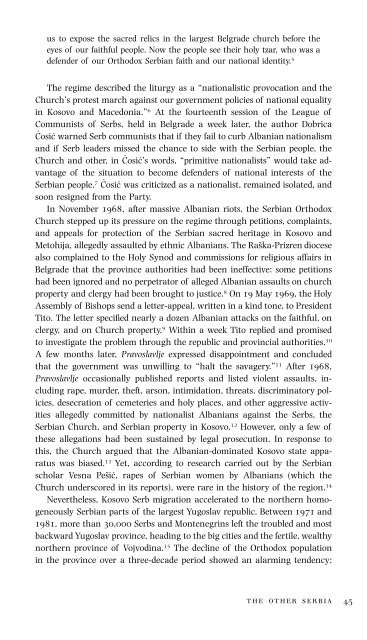Balkan Idols: Religion and Nationalism in Yugoslav States
Balkan Idols: Religion and Nationalism in Yugoslav States
Balkan Idols: Religion and Nationalism in Yugoslav States
Create successful ePaper yourself
Turn your PDF publications into a flip-book with our unique Google optimized e-Paper software.
us to expose the sacred relics <strong>in</strong> the largest Belgrade church before the<br />
eyes of our faithful people. Now the people see their holy tzar, who was a<br />
defender of our Orthodox Serbian faith <strong>and</strong> our national identity. 5<br />
The regime described the liturgy as a “nationalistic provocation <strong>and</strong> the<br />
Church’s protest march aga<strong>in</strong>st our government policies of national equality<br />
<strong>in</strong> Kosovo <strong>and</strong> Macedonia.” 6 At the fourteenth session of the League of<br />
Communists of Serbs, held <strong>in</strong> Belgrade a week later, the author Dobrica<br />
Ćosić warned Serb communists that if they fail to curb Albanian nationalism<br />
<strong>and</strong> if Serb leaders missed the chance to side with the Serbian people, the<br />
Church <strong>and</strong> other, <strong>in</strong> Ćosić’s words, “primitive nationalists” would take advantage<br />
of the situation to become defenders of national <strong>in</strong>terests of the<br />
Serbian people. 7 Ćosić was criticized as a nationalist, rema<strong>in</strong>ed isolated, <strong>and</strong><br />
soon resigned from the Party.<br />
In November 1968, after massive Albanian riots, the Serbian Orthodox<br />
Church stepped up its pressure on the regime through petitions, compla<strong>in</strong>ts,<br />
<strong>and</strong> appeals for protection of the Serbian sacred heritage <strong>in</strong> Kosovo <strong>and</strong><br />
Metohija, allegedly assaulted by ethnic Albanians. The Rasˇka-Prizren diocese<br />
also compla<strong>in</strong>ed to the Holy Synod <strong>and</strong> commissions for religious affairs <strong>in</strong><br />
Belgrade that the prov<strong>in</strong>ce authorities had been <strong>in</strong>effective: some petitions<br />
had been ignored <strong>and</strong> no perpetrator of alleged Albanian assaults on church<br />
property <strong>and</strong> clergy had been brought to justice. 8 On 19 May 1969, the Holy<br />
Assembly of Bishops send a letter-appeal, written <strong>in</strong> a k<strong>in</strong>d tone, to President<br />
Tito. The letter specified nearly a dozen Albanian attacks on the faithful, on<br />
clergy, <strong>and</strong> on Church property. 9 With<strong>in</strong> a week Tito replied <strong>and</strong> promised<br />
to <strong>in</strong>vestigate the problem through the republic <strong>and</strong> prov<strong>in</strong>cial authorities. 10<br />
A few months later, Pravoslavlje expressed disappo<strong>in</strong>tment <strong>and</strong> concluded<br />
that the government was unwill<strong>in</strong>g to “halt the savagery.” 11 After 1968,<br />
Pravoslavlje occasionally published reports <strong>and</strong> listed violent assaults, <strong>in</strong>clud<strong>in</strong>g<br />
rape, murder, theft, arson, <strong>in</strong>timidation, threats, discrim<strong>in</strong>atory policies,<br />
desecration of cemeteries <strong>and</strong> holy places, <strong>and</strong> other aggressive activities<br />
allegedly committed by nationalist Albanians aga<strong>in</strong>st the Serbs, the<br />
Serbian Church, <strong>and</strong> Serbian property <strong>in</strong> Kosovo. 12 However, only a few of<br />
these allegations had been susta<strong>in</strong>ed by legal prosecution. In response to<br />
this, the Church argued that the Albanian-dom<strong>in</strong>ated Kosovo state apparatus<br />
was biased. 13 Yet, accord<strong>in</strong>g to research carried out by the Serbian<br />
scholar Vesna Pesˇić, rapes of Serbian women by Albanians (which the<br />
Church underscored <strong>in</strong> its reports), were rare <strong>in</strong> the history of the region. 14<br />
Nevertheless, Kosovo Serb migration accelerated to the northern homogeneously<br />
Serbian parts of the largest <strong>Yugoslav</strong> republic. Between 1971 <strong>and</strong><br />
1981, more than 30,000 Serbs <strong>and</strong> Montenegr<strong>in</strong>s left the troubled <strong>and</strong> most<br />
backward <strong>Yugoslav</strong> prov<strong>in</strong>ce, head<strong>in</strong>g to the big cities <strong>and</strong> the fertile, wealthy<br />
northern prov<strong>in</strong>ce of Vojvod<strong>in</strong>a. 15 The decl<strong>in</strong>e of the Orthodox population<br />
<strong>in</strong> the prov<strong>in</strong>ce over a three-decade period showed an alarm<strong>in</strong>g tendency:<br />
the other serbia 45


